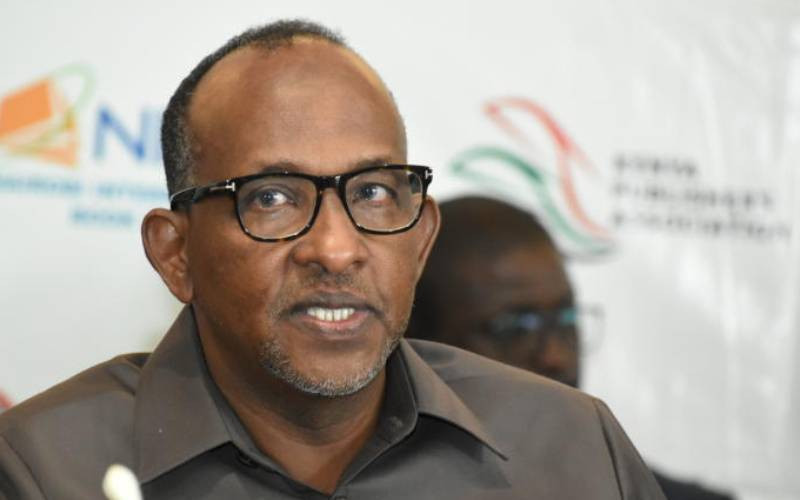By Ferdinand Mwongela
Livestock farming is a key economic activity in many parts of the country with the industry contributing significantly to agricultural gross domestic product (GDP), the second largest contributor to the country's GDP behind the service industry.
However, for many people when livestock farming is broached, cattle rearing is the first thing that comes to mind. But what many might not know is that the areas of sheep and goat farming is full of potential and with more focus and development could contribute more to the economy and the wellbeing of the people.
Handling goats
Hn the upcoming Brookside Livestock Breeders Show and Sale, slated for early next month, sheep and goats will be among animals on show as well as demonstrations on their handling in a forum that the organisers point out is geared at bettering the entire livestock industry.
In 2009, the number of goats and sheep in the country stood at about 44 million. This is against 17 million for cattle. Reared mainly for meat, goats and sheep provided about 78 tonnes of meat in 2007.
Despite these numbers, however, a lot more can be done in the sheep and goat farming industries to give them a more prominent place in the livestock industry.
Dairy goat farming, though a serious enterprise in some countries, is still not commercialised in Kenya. According to Sebastian Kariuki, Brookside Dairy’s Extension Services manager, sheep and goat farming has a lot of potential.
"You can have goat and sheep farming as a commercial enterprise," he says. He adds that people just need to know how to utilise them to be profitable.
Players in the livestock industry are, however, not blind to the potential of this segment of the livestock development sector and Kariuki points out that the Brookside Livestock Breeders Show and Sale will be a great place for farmers and other stakeholders to learn more about sheep and goat farming.
Jacob Kikang’a, Brookside’s Gicheha farm manager says some of the activities at the show will be a demonstration on the handling of these animals, all geared at educating farmers and encouraging more interest in the sector.
The approach to this category of livestock is slightly different from that of dairy livestock farming given that most of these animals are raised for meat and in the case of dairy goats, it is subsistence milk production given that dairy goat farming is still not commercialised in the country.
Kariuki points out that although dairy goat farming is viable, it has still not picked up. He, however, adds that some people make money from goat milk albeit at a lower scale compared to dairy cattle.
Source of income
For these people, goat milk supplements their income and Kariuki hopes that with time dairy goat farming will become a serious commercial enterprise. He blames the low interest in the sub sector on technical inability and information flow.
Stay informed. Subscribe to our newsletter
According to a paper on goat production in Central and East Africa, the goat population in the world is estimated to be about 744 million with about 30 per cent of this population found in Africa.
The commercial potential stands out with another paper on dairy goat production practices on Kenya presented to the Livestock Research for Rural Development points out that "dairy goat farming is an activity that can generate income, create employment opportunities and provide food security."
This paper by Egerton University’s Ogola, Nguyo and Kosgey states that the "development of crossbreds between local and exotic goats may be a solution to the prevailing environmental, nutritional, production and management constraints."
This is something that Gicheha farm has tried with their sheep population by introducing the Dorper breed from South Africa and according to the farm manger the potential is limitless.
"We have improved on birth weight," he says adding that the crossing of the exotic dorpers with the local dorper breed enabled the farm increase the birth weight of their dorpers to 4.5 kilogrammes for the males and 4.2 for the females up from 3.8 kilograms and 3.5 kilogrammes from the male and females respectively.
Gikang’a says the dorper is a hardy sheep that does well.
The farm will be among those taking part at the show exhibiting their dorper breed. "We want to show what type of sheep we are growing on this farm’s says the farm manager.
Serious enterprise
Kariuki points out that keeping goat for meat can be a serious enterprise in many areas of the country. His focus is on the arid and semi-arid areas where he says goat meat production can thrive with indigenous goat breeds suited for these areas.
He singles out the gala goat as the future of meat production in the country.
Thus for people like Gicheha and Gikang’a the future looks bright for this segment of the livestock industry and hopefully it will step up to play a much bigger role.
 The Standard Group Plc is a
multi-media organization with investments in media platforms spanning newspaper
print operations, television, radio broadcasting, digital and online services. The
Standard Group is recognized as a leading multi-media house in Kenya with a key
influence in matters of national and international interest.
The Standard Group Plc is a
multi-media organization with investments in media platforms spanning newspaper
print operations, television, radio broadcasting, digital and online services. The
Standard Group is recognized as a leading multi-media house in Kenya with a key
influence in matters of national and international interest.
 The Standard Group Plc is a
multi-media organization with investments in media platforms spanning newspaper
print operations, television, radio broadcasting, digital and online services. The
Standard Group is recognized as a leading multi-media house in Kenya with a key
influence in matters of national and international interest.
The Standard Group Plc is a
multi-media organization with investments in media platforms spanning newspaper
print operations, television, radio broadcasting, digital and online services. The
Standard Group is recognized as a leading multi-media house in Kenya with a key
influence in matters of national and international interest.








